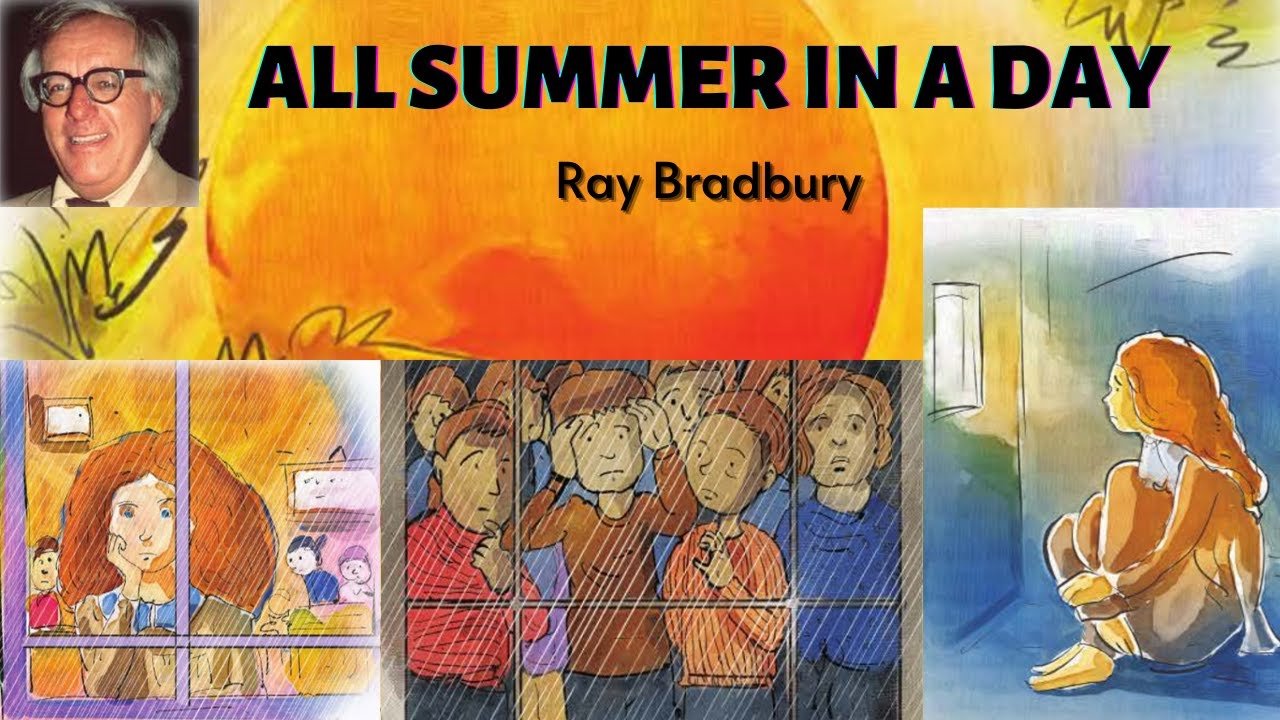All Summer in a Day Workbook Answers of Treasure Trove (2025 Edition)
“All Summer in a Day Workbook Answers of Treasure Trove,” by Ray Bradbury, remains a cornerstone in the ICSE Treasure Trove Short Stories collection. This guide delivers complete workbook answers and contextual insights to help students master every analysis point from theme and character traits to literary devices and exam relevant interpretations. Each answer is concise, factual, and aligned with ICSE marking guidelines (2025 pattern).
Story Overview: A Brief Recap
To understand the workbook questions, it is essential to grasp the story’s core.
-
Author: Ray Douglas Bradbury (1920 – 2012)
-
Genre: Science Fiction / Social Psychological Fable
-
Setting: Venus — a world of perpetual rain
-
Time Frame: Future colonial era of space migration
-
Protagonist: Margot, a nine-year-old Earth-born child
-
Antagonist: William and the class group symbolizing collective cruelty
Bradbury portrays human envy under extraterrestrial conditions — proving that emotion, not environment, shapes morality.
Workbook Answers Comprehensive Key (Section Wise)
Passage 1 Analysis Waiting for the Sun
| Question | Answer (Key Points) |
|---|---|
| 1. Where is the story set? | On Venus, where it rains continuously for seven years. |
| 2. What event are the children awaiting? | The appearance of the sun predicted by scientists to last for two hours. |
| 3. Describe the environment. | A gray, wet atmosphere; forests grow and crumble under ceaseless rain. |
| 4. Why do the children press against windows? | To catch the first glimpse of sunlight after seven years of darkness. |
| 5. Why is the moment historic? | It represents hope, renewal, and the only chance to see the sun. |
Passage 2 Margot and Her Isolation
-
Margot’s Origin: Born on Earth; moved to Venus five years ago.
-
Difference: She remembers the sun; her classmates do not.
-
Emotional State: Silent, melancholic, withdrawn.
-
Conflict: Jealousy from peers who mock her memories.
-
Result: They lock her in a closet before the sun appears.
Answer Summary: Margot embodies truth and vulnerability. Her classmates symbolize collective intolerance toward difference.
Theme and Central Idea
-
Main Theme: Envy and alienation within childhood society.
-
Supporting Themes:
-
Suppression of individuality
-
Memory vs. oblivion
-
Consequence of cruelty
-
Value of light (symbolic of truth and empathy)
-
Bradbury presents sunlight as a metaphor for compassion and understanding, contrasted with the darkness of ignorance.
Character Sketch Margot
| Trait | Description |
|---|---|
| Sensitive | Reacts deeply to music and light. |
| Truthful | Never lies about her memory of the sun. |
| Introverted | Avoids play and noise; withdrawn from peers. |
| Courageous | Speaks against mockery despite isolation. |
| Tragic Victim | Loses her only chance to see the sun. |
Interpretation: Margot is a symbol of pure innocence in a world dominated by collective unkindness.
Literary Devices and Language Features
| Device | Example | Function |
|---|---|---|
| Simile | “Pressed to each other like so many roses.” | Creates visual imagery of closeness and anticipation. |
| Metaphor | “The sun is a flower.” | Equates light with life and renewal. |
| Personification | “The rain fell in giant streams and rushed like a storming army.” | Makes nature a living force. |
| Alliteration | “Drum and gush of rain.” | Builds musical rhythm and tension. |
Deeper Analysis Social and Psychological Angles
The Symbolism of Rain and Sun
-
Rain represents social pressure and emotional suppression.
-
Sun symbolizes clarity, truth, and freedom from fear.
-
Closet is a metaphor for oppression of truth.
Bradbury’s Venus mirrors any society where conformity destroys compassion.
The Children’s Cruelty and Its Motive
The children’s actions stem from psychological insecurity.
They envy Margot’s connection to something they cannot comprehend.
Bradbury implies that jealousy thrives in ignorance, especially in closed environments like Venus.
The Climax and Resolution
-
Climax: The sun appears while Margot is locked away.
-
Falling Action: Children play in sunlight and forget her.
-
Resolution: When rain returns, they realize their mistake and silently release her.
Moral Lesson: Cruelty cannot erase truth; remorse cannot reverse loss.
Style and Narrative Technique
Bradbury’s prose is poetic yet precise. He combines:
-
Repetition – to amplify mood (“It rained and rained and rained.”)
-
Imagery – to immerse readers in Venus’s gloom.
-
Contrast – between light and darkness to portray moral conflict.
This fusion of poetry and psychology makes the story memorable for students and critics alike.
Key Takeaways for Students
-
Always link answers to textual evidence.
-
Define themes using exact phrases from the story.
-
Write in active voice; avoid speculation.
-
Mention author and genre in intro answers.
-
Summarize with moral insight, not personal opinion.
Earth vs. Venus in Bradbury’s World
| Aspect | Earth | Venus |
|---|---|---|
| Climate | Balanced sun and rain | Endless rain and cloud cover |
| Emotional Tone | Joyful and creative | Depressive and monotonous |
| Freedom | Open movement | Confinement indoors |
| Society | Empathetic | Competitive and envious |
| Light Symbolism | Constant hope | Rare revelation |
Vocabulary List and Word Meanings
| Word | Meaning | Usage in Context |
|---|---|---|
| Compounded | Intensified by addition | “The rain was compounded of storms.” |
| Tumultuously | Noisily and wildly | “The children ran tumultuously outside.” |
| Concussion | Violent shaking | “The concussion of storms echoed through Venus.” |
| Resilient | Able to recover quickly | “The forest was resilient to rain.” |
| Surge | Sudden movement | “A surge of light filled the classroom.” |
Top Exam-Relevant Questions (With Sample Answers)
Q1. How does Bradbury create suspense in the story?
He builds anticipation through imagery and repetition. The children’s impatience and the scientists’ prediction heighten tension until the sun appears.
Q2. What lesson does the story teach about human nature?
It teaches that jealousy and ignorance lead to cruelty, while remorse comes too late to heal harm.
Q3. Why is the title “All Summer in a Day” appropriate?
Because the children experience in two hours the joy that others on Earth feel for an entire season.
Q4. How is Margot different from her peers?
She retains Earth’s memory of sunlight and beauty, making her more sensitive and isolated among the Venus-born children.
Additional Interpretations for Higher Marks
Psychological Symbolism
-
Margot’s silence = emotional suppression.
-
The sunlight = human consciousness.
-
Children’s mockery = fear of truth and difference.
Sociological Reading
Bradbury reflects how societies ostracize minorities who remember better times or truths. Venus functions as a metaphor for industrial uniformity.
Philosophical Inference
“All Summer in a Day” suggests that light exists within memory, even if society tries to erase it. Margot’s faith in the sun is a testament to inner truth.
FAQs
Q1. What is “All Summer in a Day” about in Treasure Trove?
It is a science-fiction story by Ray Bradbury set on Venus, where the sun shines once every seven years, focusing on a girl named Margot who remembers sunlight while others do not.
Q2. Who is the main character in “All Summer in a Day”?
Margot is the main character, a nine-year-old Earth immigrant whose longing for the sun sets her apart from her classmates.
Q3. What is the moral lesson of the story?
The story teaches empathy, warning against cruelty driven by jealousy and conformity.
Q4. What is the symbol of the sun in the story?
The sun symbolizes truth, hope, freedom, and the awakening of human emotion.
Q5. Why do students lock Margot in the closet?
They envy her knowledge of sunlight and wish to deny her the joy of seeing it again.
Q6. How does the story end?
The sun sets, rain returns, and the children realize their mistake as they release Margot from darkness in silence.
Q7. Is the title “All Summer in a Day” symbolic?
Yes. It compresses an entire season of joy into a single day of light, reflecting the brevity of happiness in life.
Q8. Who is the author of this story in the Treasure Trove collection?
The author is Ray Bradbury, an American writer known for speculative and psychological fiction.
Q9. How is Venus portrayed in the story?
Venus is a dark, rain-soaked planet where children grow without light or freedom, symbolizing societal confinement.
Q10. What literary techniques does Bradbury use?
He uses metaphor, personification, imagery, and contrast to portray tension between light and darkness.
Learn More: Introduction: What Is bunkr fi f nheqaf2r5zplr
Aponeyrvsh: The Definitive Guide to a Unique Concept
Conclusion
The “All Summer in a Day Workbook Answers of Treasure Trove” resource here integrates exam-oriented precision with literary depth.
It transforms routine answers into a complete analysis of Bradbury’s moral vision — a vision where light represents truth and silence reveals human guilt.






